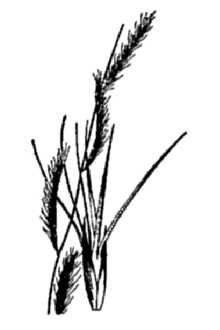Red Grama
Scientific Name: Bouteloua trifida Thurb.

| General Information | |
|---|---|
| Usda Symbol | BOTR2 |
| Group | Monocot |
| Life Cycle | Perennial |
| Growth Habits | Graminoid |
| Native Locations | BOTR2 |
Plant Guide
Use soil moisture sensors to measure the soil moisture of Red Grama.
Fact Sheet
Uses
All livestock graze red grama. Forage production is low, but quality is good when plants are green.
Status
Please consult the PLANTS Web site and your State Department of Natural Resources for this plant’s current status, such as, state noxious status and wetland indicator values.
Description
Grass Family (Poaceae), Red grama is a native, warm-season, weak perennial grass, The height is between 5 to 10 inches, The leaf blade is short, narrow flat or rolling, and the surface slightly rough with scattered long hairs on the margin, The leaf sheath is shorter than the internodes and smooth or slightly rough, The ligule has a ring of short hairs, The stem is smooth, Young plants are erect and the old plants are bent at the base, The nodes are naked and darker than the rest of stem, Use soil moisture sensors to measure the soil moisture of Red Grama., The seedhead is 3 to 7 spikes per seedhead and about 12 spikelets per spike, The rachis is hairy and the fertile lemma of each spikelet is tipped with 3 short awns, Distribution: For current distribution, please consult the Plant Profile page for this species on the PLANTS Web site,
Management
After seedbeads appear, nutritive value declines rapidly. This grass helps to protect soil from wind and water erosion if lightly grazed. Growing points and basal leaves are so close to the ground that most livestock cannot harvest more than 50 percent of current year's growth by weight. Deferred grazing during the growing season every 2 to 3 years maintains plant vigor and allows the plants to mature seed for maintaining a stand. This grass is seldom a key management species, except on ranges where it grows in almost pure stands.
Establishment
Growth starts in the spring when daytime temperature is about 70' F and moisture is adequate, and seeds mature 6 weeks after growth starts. Because of this characteristic, red grama is often referred to as 6 weeks' grama. It reproduces from seed, has a shallow root system, and becomes semi-dormant during the summer. It is adapted to shallow, gravelly, stony soils in southwest Texas that have a poor soil-moisture relationship. It invades deep, loamy soils denuded by overgrazing. Cultivars, Improved and Selected Materials (and area of origin) Please contact your local NRCS Field Office.
